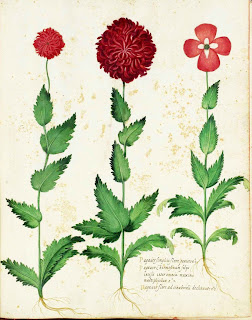Hi
everyone! I have a fun, ‘new’ recipe for you to try! It’s from a guide and
cookbook put together by the Goodman of Paris, an “upright French landowner of
sixty,” for his young wife, who would be entering into his household at 15
years old.[1] The
whole guide itself was written in the late 14th century, and
includes instructions on how to manage the household affairs, an herbal section
and recipes “taken from books in his library.”[2] It
does sound like an invaluable record of life for the upper-middle class of
France at this time, and I would be very happy to see his section on plants and
their uses for our herbal. But for now, this recipe I’m going to give you has
the, perhaps misleading, name of pottage, but it is NOT every-day peasant fare,
rather, this recipe is for a “genteel dish,” as Maggie Black calls it, because
it uses fine white bread, wine and “precious white sugar.”[3] The
instructions are very detail and thorough, ranging in subjects from issues with
the servants to shopping. I guess he wanted her to get it right…well, he meant
well anyway, and we get a yummy recipe from it too! Enjoy!
“Cherry
pottage Wash the cherries and discard the
2
lbs fresh ripe red cherries stems
and stones. Purée the fruit in a
1 ½
cups red wine blender with 10 tablespoons of the
6 oz.
white sugar wine and half the sugar. Add more
2
oz. unsalted butter wine
if needed. Melt the butter in a
8
oz. soft white bread crumbs saucepan,
add the fruit purée, bread-
Pinch
of salt crumbs,
and remaining wine and
sugar,
and the salt. Simmer, stirring
Flower
heads of small clove pinks steadily,
until the purée is very thick.
or gilded
whole cloves (Soluble gold gouache Pour
in a serving bowl, cover and let
can
be used to gild the tops of whole cloves, cool.
When quite cold, decorate the
but
do not bite them; they stun the
taste-buds) edge of
the bowl with flowers or
[gilded]
cloves. And sprinkle coarse
Course
white sugar for sprinkling sugar
over the center.”[4]
Maggie
Black finishes off this yummy recipe by telling us that “any hostess, married
or not, would enjoy showing off this pretty recipe.”[5]
[1] Black,
Maggie, The Medieval Cookbook, Los
Angeles: Getty Publishers, 2012.
[2]
Ibid.
[3]
Ibid.
[4] Ibid. emphasis added. Also, see my blog on carnations and John Harvey's article "Gillyflower and Carnation" for more discussion on clove pinks.
[5]
Ibid.
Image appears with recipe in The Medieval Cookbook. 'European Columbines and Sweet Cherry' from Mira calligraphiae monumenta, Joris Hoefnagel, Vienna, Austria, 1291-96. Watercolors, gold and silver paint and ink on parchment.




